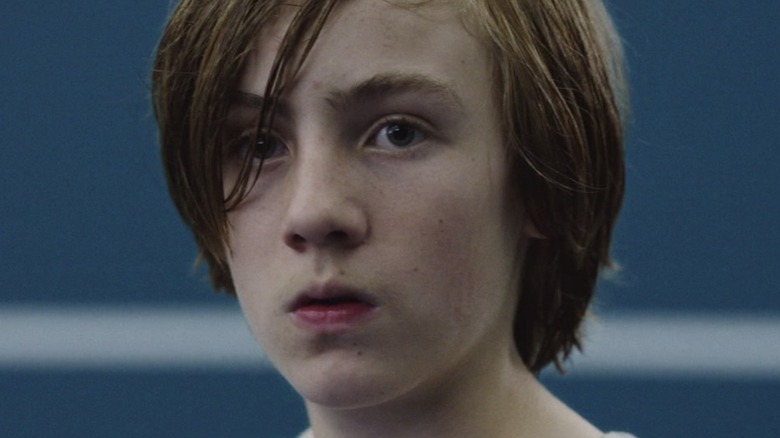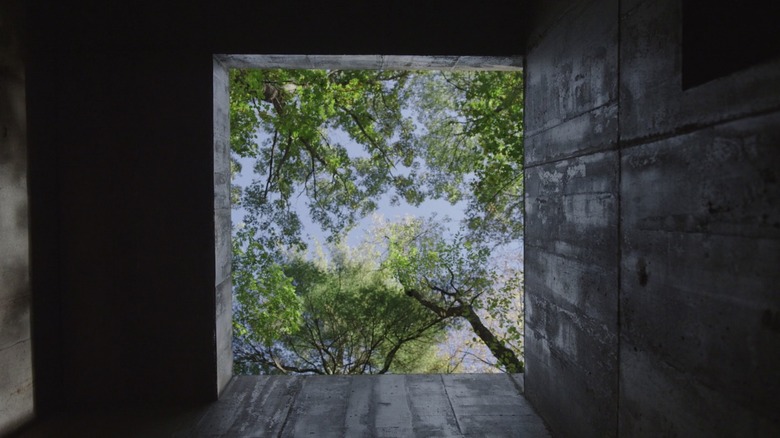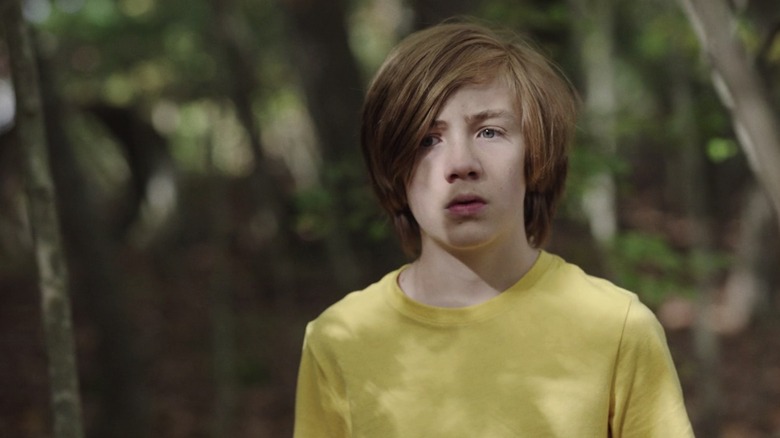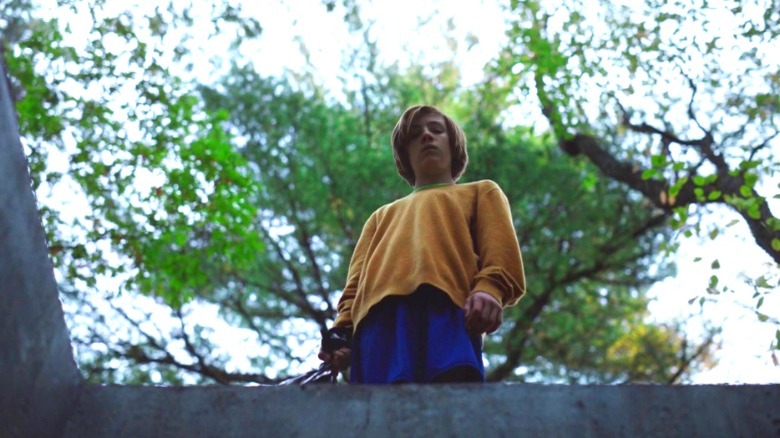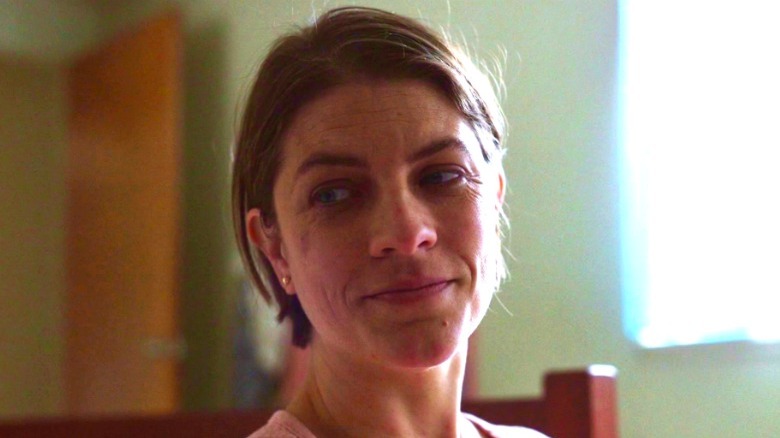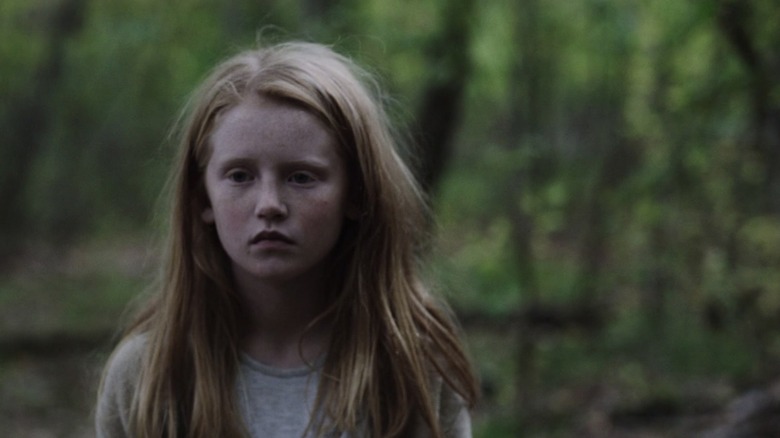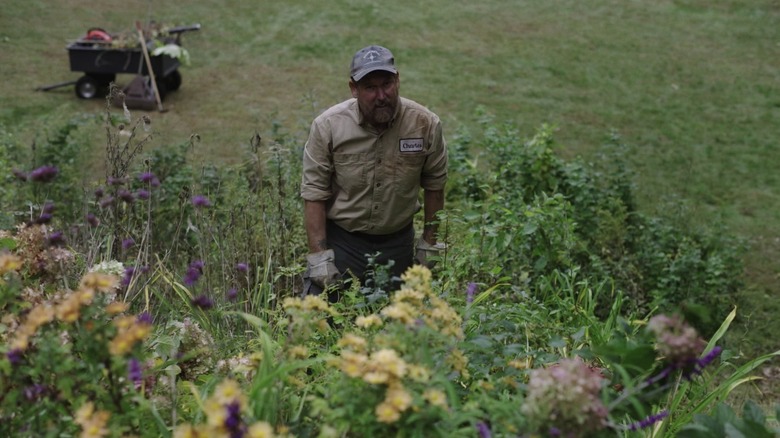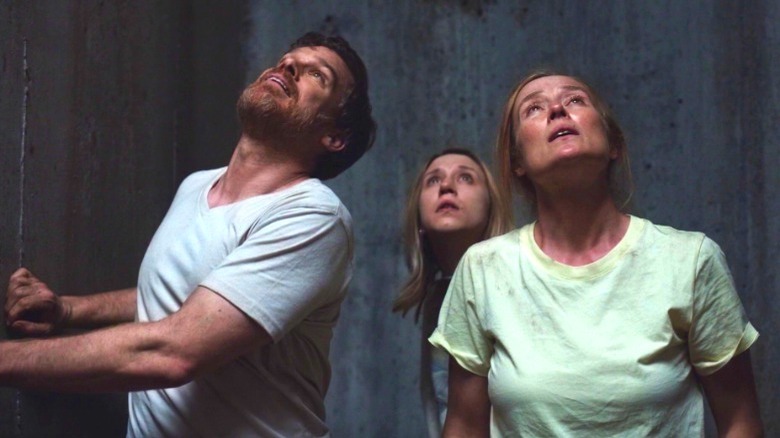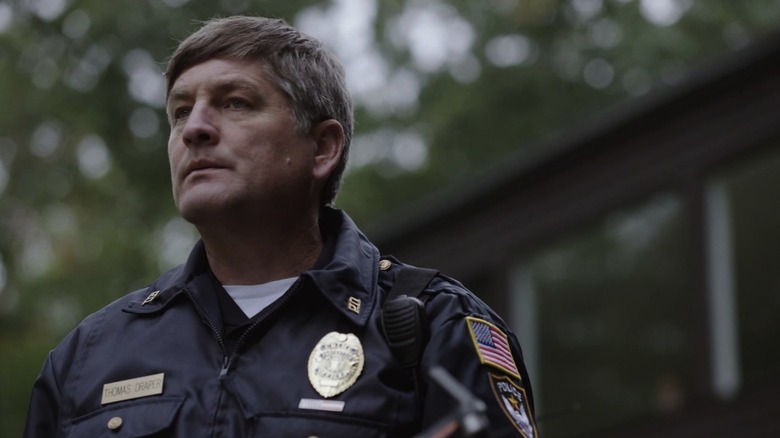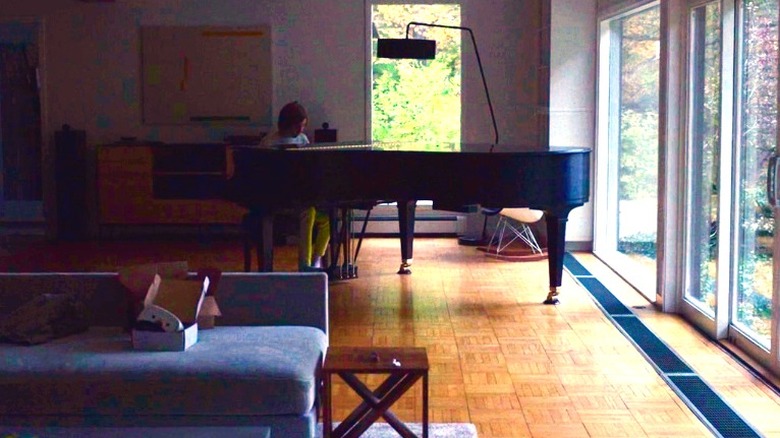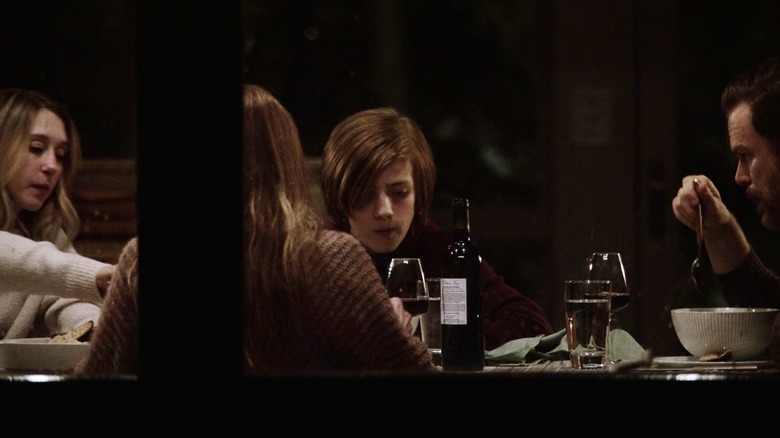The Ending Of John And The Hole Explained
"John and the Hole" is an adaptation of Argentine novelist and "Birdman" screenwriter Nicolás Giacobone's short story "El Pozo." It is a hypnotic and bizarre tale about a 13-year-old boy, played by "Captain Fantastic" breakout star Charlie Shotwell, who drugs his family before trapping them in an abandoned and unfinished bunker in the woods near their idyllic New England home.
While flying an expensive drone, John (Charlie Shotwell) finds a deep hole in the woods behind his house. After injuring himself while trying to retrieve the drone from a tree, John takes some of his mom's pills, discovering they make him drowsy. John is an inquisitive child, always asking strange questions that have recently been about what it feels like to be an adult. After finding the hole and taking the pills, John hatches a plan to keep his family out of the way while he indulges in the fantasy he is a grown-up.
When Anna (Jennifer Ehle), Brad (Michael C. Hall), and their daughter Laurie (Taissa Farmiga) wake up in a nest of pillows and blankets at the bottom of a deep hole in the woods, they are worried something has happened to their youngest child. Pascual Sisto's puzzling directorial debut leaves us with more questions than answers. If this "Home Alone"-turned-domestic-horror-style movie left you perplexed, stick with us as we try to deconstruct this enigmatic indie film.
What's up with the retro boxy aspect ratio of the film?
One of the first things you might notice while viewing "John and the Hole" is that the entire film is shot by Dutch cinematographer Paul Özgür, in a box-like 4:3 ratio style, giving it a retro television look with tightly framed shots and closeups. Some critics felt this choice imbues the film with a sense of paranoia, while another critic concluded that the frame mirrors the claustrophobia John's family experienced while trapped in the concrete-lined hole.
This constrained view also mimics the emotional claustrophobia and restlessness teens experience when they are itching to leave the nest. John's recent interest in what it feels like to be an adult suggests John has reached the age when still being seen and treated as a child chafes against a teenager's desire for independence and agency. The tight frame reflects a teen's feelings of being trapped while waiting for their life to begin in adulthood.
Carlos Aguilar with The Wrap wrote, "since the entire picture is crafted in a boxy aspect ratio. The hole creates a frame-within-a-frame effect." This visual composition might also reflect the relationship between Gloria (Georgia Lyman) and Lily's (Samantha LeBretton) bewildering subplot and the story of "John and the Hole." Further, this visual structure hints at how the story structure may help us understand the film's ending.
What is wrong with John?
Director Pascual Sisto resisted diagnosing John, telling Tim Grierson with Mel Magazine "We always wanted to say, What if this is a story of a character that doesn't [do something terrible], but has the same issues and the same problems that you see in all these [other] kids?" Sisto didn't see John's personality as mimicking "the classic example of the school shooter," although he recognizes some viewers are more comfortable thinking of John as someone with a condition or mental illness.
Despite Sisto's perspective on John, some critics had no hesitation in labeling the icy adolescent with a personality disorder. John's wooden affectation, eerie silence, monotone voice, and blank stare certainly make him seem creepy. Audiences are left to dread his emotional distance becoming too dangerous and possibly even homicidal. In the scenes where John and Peter (Ivy "Ben" O'Brien) play at drowning each other in the pool, there is a creeping sensation that this will be the moment John crosses the line. He doesn't. In fact, during the scenes with Peter, John is animated and more "normal."
We never learn what is wrong with John. Obviously, he is unusual, but his family doesn't discuss it beyond joking about his "weird" questions. Critics have plenty to say and agree, calling John a "creepy kid," who is "aloof," and "a serial killer in the making." Movie Web described him as being "depicted as a sociopath, not a psychopath," and The Los Angeles Time echoed that armchair analysis.
If you or someone you know needs help with mental health, please contact the Crisis Text Line by texting HOME to 741741, call the National Alliance on Mental Illness helpline at 1-800-950-NAMI (6264), or visit the National Institute of Mental Health website.
Is the hole in the woods symbolic for an emotional void inside John?
The title "John and the Hole" is a bit on the nose. It seems to be a reference to the void inside John that would allow him to do something like this to his family and hardly feel any remorse, empathy, or anxiety about his actions. John's blank face and monotonous speech style hint at his inner emptiness, which is something multiple critics comment on regarding John and the film itself.
David Rooney with The Hollywood Reporter praised Shotwell's performance as "rivetingly affectless" for his portrayal of apathy while calling the film "amply compelling even if there's a slight hollowness to the film." Film critic Tomris Laffly praised the film in a 3.5-starred review, noting, "There seems to be a gaping abyss in John's soul where his conscience and youthful bliss ought to be." Almost all the adults in the film interpret John's soft-spoken demeanor and calm façade as politeness, but his sister Laurie sees John clearly enough to know he trapped them in the hole. Decider suggested John binges on junk food and spends money in an effort to fill the emptiness inside.
Signal Horizon pegged the hole as "a physical place that John lowers his family into while they are unconscious and a metaphorical emptiness." Although it is easy to see John as emotionally empty and numb in a disturbing way, he might also be the conduit through which the filmmaker explores the emptiness of modern life, which is increasingly devoid of meaningful connections.
Lily and her mother Georgia are the key to understanding the ending of film
The perplexing subplot about Lily and her mother Gloria enters the film 30 minutes in, just after John transports Brad to the hole while unconscious in a wheelbarrow. Gloria enters her daughter Lily's bright bedroom, concerned Lily hasn't left the room in 24 hours and doesn't want to use the restroom. After chastising Lily for lying, Gloria asks if Lily wants to hear a story, and she requests the story about the hole, cutting to a title card saying "John and the Hole" at the half-hour mark of the film.
Initially, we expect John's path to cross with Gloria's during the film, explaining how Gloria knows about John, effectively tying the two storylines together. This development never happens, though, which leaves audiences to wonder how Lily and Gloria relate to the rest of the film. Some critics, including Julian Roman with Movie Web, found this subplot puzzling, noting that it is "seemingly unrelated" and nonsensical.
While this B-plot does feel abrupt and disjointed, the strategic placement of these three vignettes featuring Lily — which last approximately every 30 minutes in all — suggests these scenes are important to decipher the deeper meaning of "John and the Hole." Lily's dream about a blue balloon rendered invisible by a blue sun and sky is poignant, suggesting Lily mirrors John, feeling unseen by her absent father and emotionally remote mother.
John and the Hole is a fable Lily's mother told her
An hour into the film, Lily and Gloria's storyline intrudes again when Gloria tells Lily she is leaving Lily to fend for herself. Lily replies that she is only 12 years old and not ready to fend for herself. Gloria informs Lily there is enough money in a shoebox under the bed to pay rent and survive for a year if Lily is responsible with the money. Lily begs her mother to stay to no avail before the film cuts back to John's storyline.
In the last scene of "John and the Hole," after John and his family's story has concluded in an anti-climatic reversion to normality, we revisit Lily's subplot as she walks through a forested area, with structures resembling the woods where John found the hole. The only theory that satisfactorily explains everything is that John and his family are characters in a cautionary fable Gloria told Lily to prepare her for being abandoned.
As Signal Horizon contended, "John and his family are not the main characters. Lily and her mother are the real main characters, and everything we see is a construct of the story Lily's mother tells her." Robert Daniels, with The Los Angeles Times, came to the same conclusion, calling the film, "a tale within a tale about the pressures of growing up." John can't wait to grow up, trapping his family to give adulthood a test drive, before letting them out of the hole. Meanwhile, Lily is forced to grow up when she is abandoned suddenly by her mom.
The gardener Charlie is a character in another story Georgia tells Lily
The theory that John and his family are just characters in stories Gloria tells is hinted at from the moment Gloria asks Lily if she wants to hear a story. At first, Gloria suggests "Charlie and the Spider," before Lily requests the story about the hole. We have already met Charlie, the gardener, earlier in the film when John tested out his mother's pills on Charlie by drugging his lemonade to see when the sedative would take effect and how long it would last.
Before passing out, Charlie has a strange interaction with John, in which John inquires if Charlie liked the lemonade before asking how Charlie feels. John tells Charlie there is a spider on his back, and Charlie explains to John that these garden spiders are good for gardens and are harmless before the spider bites him. When Gloria offers to tell the story, "Charlie and the Spider," this is actually our first hint that what transpires during the film is a story framed within another story.
"Charlie and the Spider" is clearly another cautionary tale about trusting the wrong people and how we can't expect people to act against their nature. Signal Horizon likened Charlie's story with the fable about the "scorpion and the frog," suggesting these stories Gloria tells Lily have the instructional value we attribute to folktales.
How did John get his family down in the hole, injuring no one?
There were other hints throughout the film that John and his family aren't fleshed-out people but characters in a cautionary fable. John drugs his family before moving them to the abandoned bunker, but did you wonder how he got them down there? Short of placing his father in a wheelbarrow, we are given no clues about how John got them down in a 30-foot-deep hole. Julian Roman with Movie Web, found it implausible, writing, "The mechanics of the abductions are not believable."
In a film that focuses on the minutiae of John's activities, like showing him playing in a meadow with a bucket on his head or taking a bath, not showing how John put them in the hole was an intentional choice on the filmmakers' part. If John really put them in the hole, we would have seen him hoisting them down with the aid of ropes and pulleys. Critic Tomris Laffly suggested we not question "the film's silently arresting, fable-like logic."
Perhaps all the things that really make little sense about "John and the Hole" were always hinted it is just Gloria's story. For example, why are Anna and Brad's phones not ringing off the hook, with employers and schools wondering where everyone is? Signal Horizon argued the inconsistencies in the story point to the fairy tale logic, saying, "This is why John can drive all over town without consequence and how he knows his parent's ATM pin."
Why didn't the police enter the residence after Paula reported John's troubling behavior?
Paula and Charlie are the adults who check on John during his week of wish fulfillment while his family is in the hole. John tried to avoid this by mimicking Anna's voice to fire Charlie with a concocted story about Brad staying home from work because of a heart condition and doing the gardening himself on doctor's orders. Charlie stops by to talk to Brad, maybe sensing something is wrong but accepts John's lies when he says no one is home.
John effortlessly convinces Paula his family went to see his ailing grandfather, who suffered a fictional heart attack, leaving John behind because he is training for the tennis qualifiers. Once they are in the hole, Brad and Anna talk about how Paula is probably freaking out because Anna was supposed to help her with a catering job. Brad says Oliver, whom we assume to be his boss or business partner, will probably call the police soon.
Paula already called the police once she realized something strange was going on when she called Anna's cell phone and heard it ringing in the other room. The police came to the house but left with a shrug when no one answered the door. This is the most blatant hint "John and the Hole" is not "real" because police have procedures and this would never happen in reality. Of course, in John's reality, these incidents help him realize this experiment is ending.
John's accomplished piano skills are too surreal to be real
At one point during the film, John fills his empty time playing classical piano while it rains on his family outside. John is an excellent pianist. If you were paying attention to the score and soundtrack of "John and the Hole," you would have noticed during the scenes John drives his father's car, the classical music playing on the car radio is the same piece John plays on the piano with such skill.
Although there are 13-year-old accomplished musicians, it is surprising this is the first instance in the film we notice John's skill, suggesting John's story is a fiction playing out in Lily's head as her mother tells the story. If John was such a skilled musician, wouldn't he be taking piano lessons besides his tennis lessons? Wouldn't his parents have reminded him to practice piano before he trapped them in the hole?
Using classical music interspersed with the haunting electronic score by Caterina Barbieri is interesting. John equates being grown-up with refined tastes, like drinking fine wine and enjoying classical music, as his parents do. When his friend Peter visits, he criticizes the classical music on the car radio, but John tells him to leave it alone. John plays this piece of music again in the background when he brings his family the risotto he has cooked, along with Brad's favorite wine, for a family dinner during their last night in the hole.
What statement is director Pascual Sisto making about affluence?
When John grows bored and lonely, he stands above the hole crying, and Laurie apologizes, although she doesn't know why. John regrets his choices and lowers a ladder into the hole so his family can climb to freedom. He doesn't wait for them. Instead, he does the deadman's float in the pool until his family finds him and jumps into the pool to save his life, discovering he is fine and was not in peril. Despite everything he has put them through, they are more concerned about him than themselves.
"John and the Hole" ends as it began, with a silent family dinner, suggesting John will face no consequences for his disturbing behavior. His family already told him as much, while trying to convince him to let them out of the hole. John and his family appear, from the outside, as a typical affluent family. They slip easily back into their routines as if this traumatic experience hasn't touched them.
Sisto spoke about his fascination with the concept of "affluenza" and the lack of accountability experienced by children of wealthy parents. Sisto told Mel Magazine, "There is a different level of confidence in the upper-middle class — there's a safety net in everything they do. There's always this sense of security that exists." While many of us see John's behavior and think he has a personality disorder, Sisto suggests John's sheltered life made him yearn for visceral experiences, but also made him unaware of consequences.
